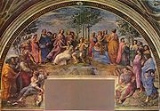
The Parnassus
Encyclopedia
The Parnassus is a painting
by the Italian
renaissance
artist Raphael
.
commissioned Raphael to decorate with fresco
es the rooms that are now known as the Stanze di Raffaello
, in the Palace of the Vatican
. It is located in the Stanza della segnatura, the first room that Raphael decorated, that portrays the four areas of human knowledge: philosophy, religion, poetry and law. The Parnassus represents poetry, ancient and Renaissance poets are centered around Apollo, who is seated on top of Mount Helicon, and nine muses.
Apollo, along with Calliope, the muse of epic poetry, inspired poets.
Two of the muses in the frescoe are reminscent of Michaelangelo's Creation of Adam, Euterpe and the named (scroll) Sappho.
The window below the frescoe Parnassus frames the view of Mons Vaticanus, believed to be sacred to Apollo. Humanists, such as Biondo, Vegio, and Albertini, refer to the ancient-sun god of the Vatican.
It was painted in 1511 as the third part, after La disputa and The School of Athens
.
where Apollo
resides. He is surrounded by the nine muses, nine poet
s from antiquity, and nine contemporary poets.
Painting
Painting is the practice of applying paint, pigment, color or other medium to a surface . The application of the medium is commonly applied to the base with a brush but other objects can be used. In art, the term painting describes both the act and the result of the action. However, painting is...
by the Italian
Italy
Italy , officially the Italian Republic languages]] under the European Charter for Regional or Minority Languages. In each of these, Italy's official name is as follows:;;;;;;;;), is a unitary parliamentary republic in South-Central Europe. To the north it borders France, Switzerland, Austria and...
renaissance
Renaissance
The Renaissance was a cultural movement that spanned roughly the 14th to the 17th century, beginning in Italy in the Late Middle Ages and later spreading to the rest of Europe. The term is also used more loosely to refer to the historical era, but since the changes of the Renaissance were not...
artist Raphael
Raphael
Raffaello Sanzio da Urbino , better known simply as Raphael, was an Italian painter and architect of the High Renaissance. His work is admired for its clarity of form and ease of composition and for its visual achievement of the Neoplatonic ideal of human grandeur...
.
Stanza della Segnatura, Vatican Palace
Pope Julius IIPope Julius II
Pope Julius II , nicknamed "The Fearsome Pope" and "The Warrior Pope" , born Giuliano della Rovere, was Pope from 1503 to 1513...
commissioned Raphael to decorate with fresco
Fresco
Fresco is any of several related mural painting types, executed on plaster on walls or ceilings. The word fresco comes from the Greek word affresca which derives from the Latin word for "fresh". Frescoes first developed in the ancient world and continued to be popular through the Renaissance...
es the rooms that are now known as the Stanze di Raffaello
Raphael Rooms
The four Stanze di Raffaello in the Palace of the Vatican form a suite of reception rooms, the public part of the papal apartments. They are famous for their frescoes, painted by Raphael and his workshop...
, in the Palace of the Vatican
Apostolic Palace
The Apostolic Palace is the official residence of the Pope, which is located in Vatican City. It is also known as the Sacred Palace, the Papal Palace and the Palace of the Vatican...
. It is located in the Stanza della segnatura, the first room that Raphael decorated, that portrays the four areas of human knowledge: philosophy, religion, poetry and law. The Parnassus represents poetry, ancient and Renaissance poets are centered around Apollo, who is seated on top of Mount Helicon, and nine muses.
Apollo, along with Calliope, the muse of epic poetry, inspired poets.
Two of the muses in the frescoe are reminscent of Michaelangelo's Creation of Adam, Euterpe and the named (scroll) Sappho.
The window below the frescoe Parnassus frames the view of Mons Vaticanus, believed to be sacred to Apollo. Humanists, such as Biondo, Vegio, and Albertini, refer to the ancient-sun god of the Vatican.
It was painted in 1511 as the third part, after La disputa and The School of Athens
The School of Athens
The School of Athens, or in Italian, is one of the most famous paintings by the Italian Renaissance artist Raphael. It was painted between 1510 and 1511 as a part of Raphael's commission to decorate with frescoes the rooms now known as the , in the Apostolic Palace in the Vatican...
.
The fresco
The fresco shows the mythological Mount ParnassusMount Parnassus
Mount Parnassus, also Parnassos , is a mountain of limestone in central Greece that towers above Delphi, north of the Gulf of Corinth, and offers scenic views of the surrounding olive groves and countryside. According to Greek mythology, this mountain was sacred to Apollo and the Corycian nymphs,...
where Apollo
Apollo
Apollo is one of the most important and complex of the Olympian deities in Greek and Roman mythology...
resides. He is surrounded by the nine muses, nine poet
Poet
A poet is a person who writes poetry. A poet's work can be literal, meaning that his work is derived from a specific event, or metaphorical, meaning that his work can take on many meanings and forms. Poets have existed since antiquity, in nearly all languages, and have produced works that vary...
s from antiquity, and nine contemporary poets.

